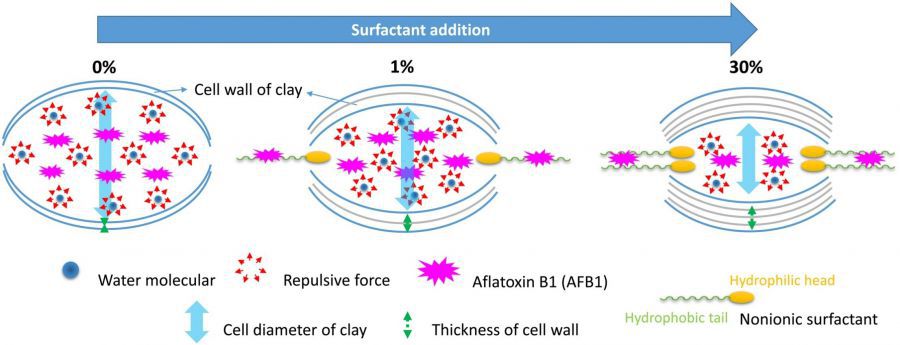| 論文篇名 | 英文:Use 3-D tomography to reveal structural modification of bentonite-enriched clay by nonionic surfactants: Application of organo-clay composites to detoxify aflatoxin B1 in chickens 中文:利用3-D顯影研究非離子型界面活性劑對富含膨潤土之黏土的結構修飾:有機黏土複合材料應用在雞隻中的黃麴毒素之移除 |
| 期刊名稱 | Journal of Hazardous Materials |
| 發表年份,卷數,起迄頁數 | 2019, 375: 312-319 |
| 作者 | Tzou, Y.M., Chan, Y.T., Chen, S.E., Wang, C.C., Ching, P.N., Teah, H.Y., Hung J.T., Wu, J.J., Liu, Y.T.* |
| DOI | 10.1016/j.jhazmat.2019.04.084 |
| 中文摘要 | 非離子型表面活性劑比陽離子和陰離子型表面活性劑相對環保,但鮮少研究將其應用在改質黏土。本篇研究中,將富含膨潤土的粘土與非離子表面活性劑混合,製備有機粘土複合材料,並了解這些改質方法是否可使雞隻降低黃麴毒素之毒性。此外,本研究首次使用穿透X光顯微鏡在對改質膨潤土在懸浮液中的3-D顯微技術進行微觀結構的特性分析。雖然X光繞射圖顯示界面活性劑改質的膨潤土原子平面之間的間距(基本間距)擴大,但3-D圖像則顯示,隨著界面活性劑添加量從1增加到30%(重量百分比),其微孔結構則逐漸收縮。由粘土的層間空間脫水引起多孔結構的下降趨勢與有機黏土複合材料上黃麴毒素的吸附量正相關。在雞隻試驗中則發現,當雞隻食用改良飼料11週後,其肝臟,腎臟和血漿中黃麴毒素的濃度則顯著低於對照組。因此,建議添加1%(重量百分比)的界面活性劑來改質膨潤土並當作雞飼料的一種改良劑去除黃麴毒素。利用非離子型界面活性劑改質的膨潤土則有望降低雞隻中黃麴毒素的累積,進而提高食品安全性並減少環境污染。 |
| 英文摘要 | Although nonionic surfactants are relatively eco-friendly compared with cationic and anionic surfactants, few studies have investigated their application in modified clay. Herein we prepared organo-clay composites (OCCs) by mixing bentonite-enriched clay (BEC) with nonionic surfactants (Brij 30 and Igepal CO-890) and determined if these modifications would enable chickens to detoxify aflatoxin B1 (AFB1). For the first time, in situ three-dimensional (3-D) microstructures of modified BEC was characterized in suspension using transmission X-ray microscopy. Although X-ray diffraction patterns indicated the expansion in the spacing between planes of atoms (basal spacing) of surfactant-modified BEC, 3-D images indicated shrinkage in its microscale porous framework with increasing surfactant additions from 1 to 30 wt%. Such declining trends in porous dimensions caused by the dehydration in interlayer galleries of clays positively correlated with sorption amounts of AFB1 on OCCs. After chickens had consumed amended feeds for 11 weeks, AFB1 concentrations in liver, kidney, and plasma were significantly lower than in the control treatment. Thus, we suggest using BEC with 1 wt% surfactant addition, an amendment to chicken feeds, to detoxify AFB1. Modifying BEC with nonionic surfactants show the promise in mitigating AFB1 accumulation in chickens, which should improve food safety and reduce environmental contamination. |
Use 3-D tomography to reveal structural modification of bentonite-enriched clay by nonionic surfactants: Application of organo-clay composites to detoxify aflatoxin B1 in chickens 2019-04-29

新穎材料農業:友善環境農業新穎材料研發與安全評估【土環系劉雨庭副教授】






